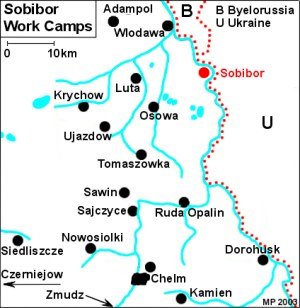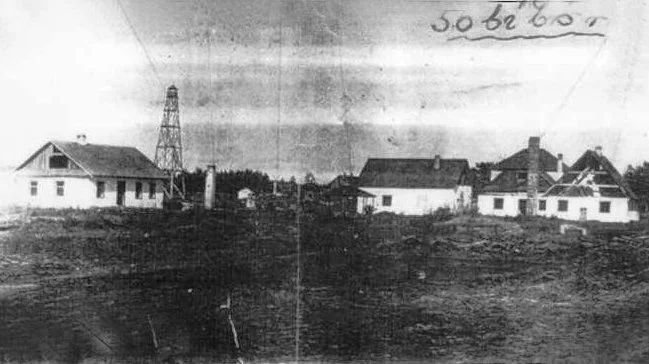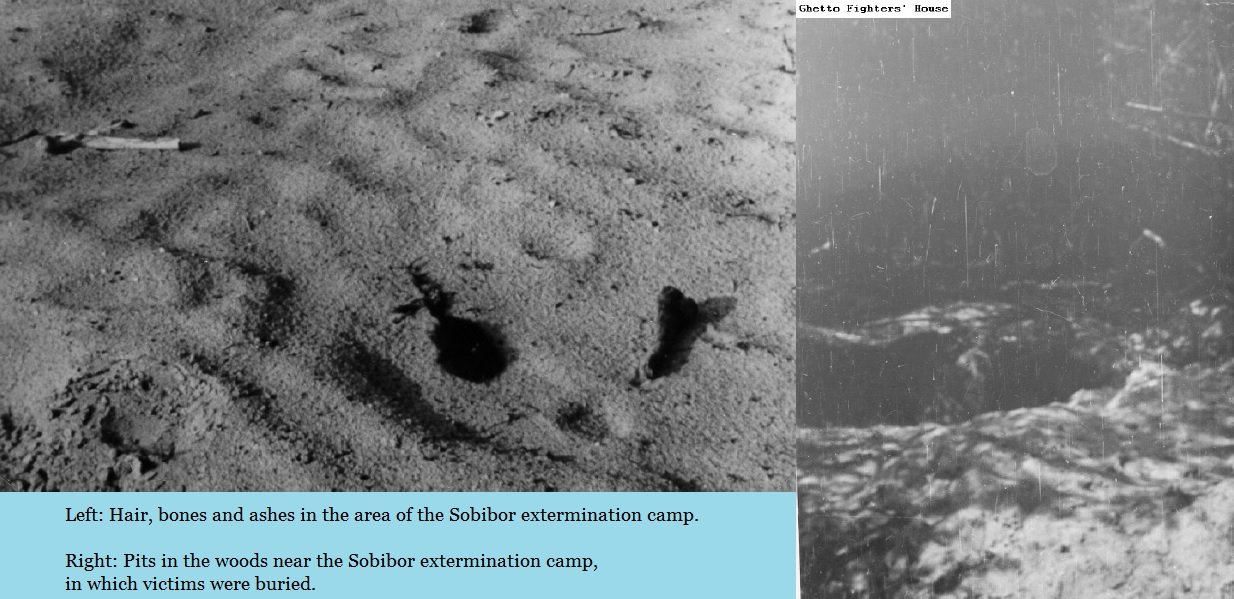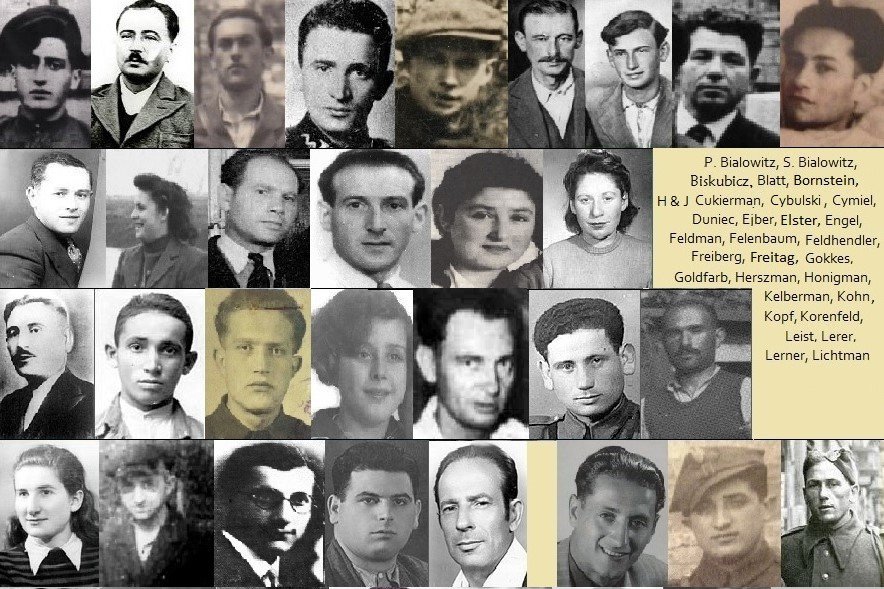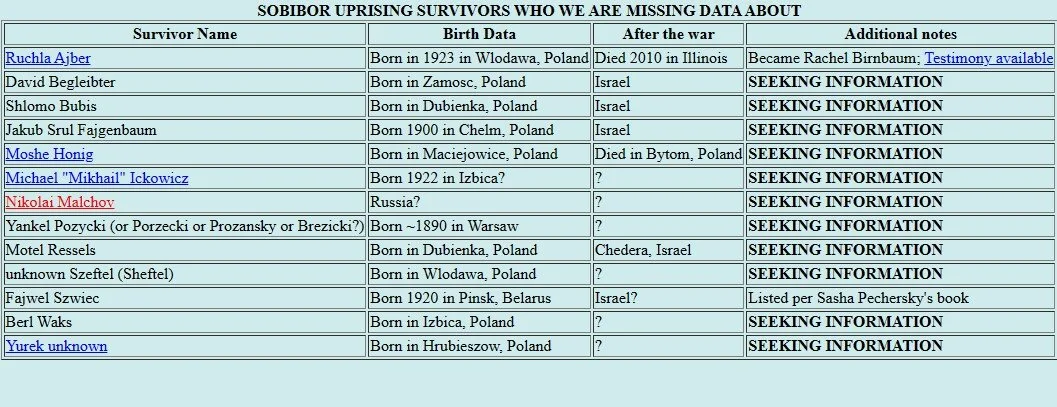The Sobibor Remembrance Project
The Death Camp Sobibor was one of the key centers for the extermination of European Jews. In 2014, additional evidence was discovered regarding the gas chambers at Sobibor Death Camp. The history of Sobibor is the theme of the memories of Thomas Blatt and Philip Bialowitz as well as the book "Escape from Sobibor". In accordance with German plans at the very beginning of the occupation of Poland, the Lublin district of eastern Poland was intended to become the crux of the Generalgouvernement's agriculture. To modernize the agriculture, a series of labor camps (sometimes referred to as the Lublin Waterworks Labor Camps) were established in Chelm district, including the following labor camps:
- Adampol
- Czerniejow
- Dorohusk
- Kamien
- Krychow
- Luta
- Nowosiolki
- Osowa
- Ruda Opalin
- Sajczyce
- Sawin
- Siedliszcze
- Sobibor village
- Staw-Sajczyce
- Tomaszowka
- Ujazdow
- Wlodawa
- Zmudz
These were the Sobibor sub-camps. The prisoners were forced to work around 10 hours per day. Many of the prisoners died of starvation, typhus, and extreme labor. In several camps like Osowa and Sawin they were shot in mass executions.
Background on the Camp
Around 140,000 Jews from the Lublin district of Poland were deported to Sobibor. Jews from other parts of Europe -- especially from Holland -- were also transported to Sobibor. HERE is a listing of transports to Sobibor Death Camp.
The Sobibor death camp was located near Sobibor village, which was located in the eastern part of the Lublin district of Poland, close to the Chelm-Wlodawa railway line. The camp was 5 km. away from the Bug River -- which today forms the border between Poland and Ukraine. A surveyor named Baurath Moser, along with S.S. Richard Thomalla, inspected the area around Sobibor in early 1942. They were looking for an area to build a second camp, to be constructed as part of the Aktion Reinhard programme. Their assignment: Walk around the railway station, take measurements and review the surrounding woods. At that time, the terrain in and around Sobibor was swampy, densely wooded and sparsely populated.
Sobibor was constructed in March of 1942 by 80 Jews from nearby ghettos (Wlodawa and Wola Uhruska). S.S. Karl Herbert Naumann -- head of the Zentralbauleitung der Waffen-SS und Polizei (Central Construction Office of the Waffen-SS and Police) in Lublin -- oversaw the camp's construction. The group of 80 Jews were gassed during an experimental gassing, however, two of them -- Shmuel Machles and Szamai Treberman from Wlodawa -- escaped by hiding in bushes. They walked from Sobibor to Wlodawa in the nude. Once at Wlodawa, they informed the local Rabbi there what was happening at nearby Sobibor. Both the escapees and the rabbi were turned in by a Jewish policeman and all of them were executed.
The Sobibor camp was in the form of a 400 x 600 meter rectangle, surrounded by a 3 meter high double barbed-wire fence, partially interwoven with pine branches to prevent observation from the outside. Along the fence and in the corners of the camp were tall, wooden watchtowers. Each of the four camp areas was individually fenced in: the SS administration area (Vorlager), housing and workshops of the Jewish commando (Camp 1), the reception area (Camp II) and the extermination area (Camp III). In 1943, a munitions supply area was added (which became Camp IV).
The Vorlager included the ramp, with space for 20 railway cars, as well as the living quarters for the S.S. staff and Trawniki-manner (the SS men lived inside the camp area). The initial commander of Camp I was S.S. Oberscharfuhrer Otto Weiss, who was replaced by Karl Frenzel. Kurt Bolender served as commander of Camp III from April 1942 until the fall of 1942, at which time he was replaced by Erich Bauer. In April, 1942 S.S. Obersturmfuhrer Franz Stangl was appointed the commandant of Sobibor; he visited Christian Wirth at Belzec death camp to obtain guidance and experience.
Jews from the incoming transports were brought to the "reception area" (Camp II), where they went through several procedures prior to being gassed. These included: Division according to sex; surrender of suitcases; confiscation of possessions/valuables; removal of clothing; and the cutting of the women's hair. The victims' hair was used for mattresses, u-boats, slippers, and more.
A path 3 to 4 meters wide and 150 meters long called Die Schlauch (The Tube) -- cynically known by the S.S. in the camp as the Himmelfahrtstrasse (Street to Heaven) -- led from the reception area to the extermination area. On either side the path was fenced in with barbed-wire, intertwined with pine branches. Through it, the naked victims were herded toward the gas chambers. The most isolated area in the camp was the extermination area (Camp III) -- located in the northwest part of the camp. It contained the gas chambers, mass graves and housing for the Jewish prisoners engaged in forced labor at this locale.
On their way to the gas chambers, naked victims passed various buildings -- warehouse barracks; a former forester's house (which was used as the camp offices and living quarters for some S.S.) separated by a high wooden fence; a small agricultural area with stables for horses, cattle, swine and geese; and a small wooden Catholic chapel, in the shadow of tall pine trees about 250 meters south of the gas chambers, became a "Lazarett" operated by S.S. man Paul Bredow. A high observation tower overlooked the entire area, manned mostly by Ukrainian guards. The three gas chambers were inside a brick building. The brick building had an annex in which a motor produced the deadly carbon monoxide gas. Water pipes connected the gas to the chambers. Each individual gas chamber was square-shaped, 4x4 meters, and had a capacity of 160-180 persons. The chambers could be entered through a door, leading from a veranda which ran the length of the building. After gassing, the bodies were removed through a 2x2 meter folding door opposite to the entrance, and placed on a second veranda. The mass graves at Belzec were 50 to 60 km. long, 10 to 15 meters wide, and 5 to 7 meters deep. At the camp, there was a small group of prisoners that was kept alive for forced labor. The group included around 400 Jewish prisoners from Poland, Germany, Netherlands, and Russia.
The uprising broke out on Sukkot -- October 14, 1943. The Jewish prisoners killed 12 German SS officers and 3 Ukrainian guards. Over 360 people tried to escape. Jews were shot at by guards aiming at them from towers. Barbed wires surrounding the camp injured the prisoners, and mines surrounding the camp killed them. 158 people died on that day. By October, 23 Germans captured and killed the next 107 fugitives. Around 58 participants of the uprising survived the war. (Approximately 8 to 10 others escaped the camp prior to the Sobibor uprising.) Their names are listed below so we can remember their heroism. The insurgents' sacrifices were not in vain. After the uprising, the Sobibor Camp ceased to exist -- saving many other possible victims of the gas chambers.
Immediately after the escape, the Nazis covered up their crimes by burning the bodies at the camp, forcing Jews from another location to come to the site to help conceal the crimes, eliminating evidence of the gas chambers, and planting trees on top of the key locations. Nazi Werner Dubois, who was injured during the revolt, was cared for by Shulim Bresler, a dentist who had somehow been recaptured by the S.S. after the revolt took place. An Austrian Jew named Karl Blau, who was at Treblinka, was transferred to Sobibor in November 1943 with his wife Adele for the purpose of dismantling the Sobibor camp and covering up the crimes. Both committed suicide. Nazi Franz Suchomel testified during the Sobibor Trial that their bodies were still dressed when found deceased in Camp III.
Some of the rebels in the camp who were involved in planning and carrying out the Sobibor uprising, but did not survive, include: Bresler, Shaul Flajszhakier, Luka Poppert-Schoenborn, Berek Lichtman, Kapo Czapik (Czepik), and Joseph Jakobs from Holland.
A small portion of the ~250,000 victims of Sobibor are remembered here, here, and here. Today a remembrance museum exists at Sobibor.
Information about the perpetrators of the crimes against humanity at Sobibor is available here. Brief biographies of S.S. operatives (including locations of origin and background) are available for some S.S. operatives here.
A layout (map) of the death camp is available here.
Sobibor Uprising Survivors
Below is a list the survivors of the uprising at Sobibor. Little is known about several of the survivors. We are seeking to correct that so we can learn what happened to each and every survivor. Brief biographies of some of the Sobibor survivors is available HERE. Photos of some of the survivors are located HERE.
SOBIBOR SURVIVORS
SOBIBOR SURVIVORS
SOBIBOR UPRISING SURVIVORS WHO WE ARE MISSING DATA ABOUT
** Pesia Lieberman escaped on Dec. 25,1942 in the evening, with Ukrainian guards Viktor Kisilew and Emil Zischer, and two unidentified Jews. The Ukrainians were armed so Lieberman went with them after the two unarmed Jews went separately. Five days later they were betrayed by a farmer while hiding in the village of Kozia Gora, Gmina Wierzbica, near Chelm, Poland. They were surrounded in a village hut and were killed in a shootout by three Polish police officers: Misnerowiec, Piescikowski and Kwiatkowski.
SOBIBOR UPRISING SURVIVORS WHO WE ARE MISSING DATA ABOUT
